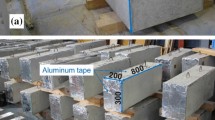Abstract
Moisture is decisive for a large number of binding and transport processes in high performance concrete affecting the durability, shrinkage and performance in various environments. An experimental study on the moisture transport properties of 20 concrete mixes was made during seven years, with type of binder, additives and waterbinder ratio as parameters. An upside-down glass cup method was used to obtain the steady-state flow through concrete discs.
The moisture diffusion coefficient decreases with a lower water-binder ratio, increasing amount of silica fume, especially when combined with fly ash and it continues to decrease also after four years for w/B lower than 0.40. The moisture diffusion coefficient is much less moisture dependent for HPC than for normal concrete, which means that steady-state moisture profiles through HPC structures will be almost linear. Long-term moisture profiles in submerged HPC will be affected by self-desiccation for a very long time because of the extremely small moisture flow.
Résumé
L'humidité a une influence prépondérante sur un grand nombre de processus d'interaction et de transport qui affectent de manière directe la durabilité, le retrait et le comportement des bétons à haute performance (BHP) soumis à différents types de conditions d'exposition. Une étude expérimentale sur les propriétés de transport d'humidité de 20 mélanges de béton a été effectuée durant une période de sept ans. Les variables étudiées concernaient le type de ciment et d'ajouts ainsi que le rapport eau/liant. Une procédure spéciale a été utilisée de manière à être en mesure de réaliser les essais de transfert d'humidité en régime permanent.
Les résultats des essais indiquent que le coefficient de diffusion d'humidité diminue avec une réduction du rapport eau/liant, une augmentation de la teneur en fumée de silice, tout particulièrement lorsque celle-ci est utilisée avec des cendres volantes. Pour des bétons de rapports eau/liant inférieurs à 0,40, la réduction du coefficient d'humidité se poursuit toujours même après 4 ans d'hydration. Le coefficient de diffusion d'humidité des BHP semble être beaucoup moins sensible à la teneur en eau que celui des bétons ordinaires ce qui signifie que les profils d'humidité en régime permanent sont presque linéaires. Les profils d'humidité à long terme dans BHP submergés seront fortement affectés par l'autodessiccation.
Similar content being viewed by others
Abbreviations
- v :
-
water vapour content of the air [kg/m3]
- v s :
-
vapour content at saturation
- RH, φ:
-
relative humidity
- w e :
-
moisture content [kg/m3] in weight of moisture per volume of concrete
- u :
-
moisture ratio[kg/kg] in weight of moisture per dry weight of concrete
- S cap :
-
degree of capillary saturation” [-]
- w/C :
-
water-cement ratio
- w/B :
-
water-binder ratio; without activity factors
- J :
-
moisture flow [kg/m2/s]
- δ:
-
moisture diffusion coefficient [m2/s]
- D w :
-
moisture diffusivity [m2/s]
References
Nilsson, L.-O., ‘The relation between the composition, moisture transport and durability of conventional and new concretes— Concrete composition, moisture and durability’. Contech'94, International RILEM Workshop on Technology Transfer of the New Trends in Concrete, 7–9 November 1994, Barcelona, 1994.
Nilsson, L.-O., ‘Hygroscopic moisture in concrete—Drying, measurements and related material properties’, TVBM-1003, Division of Building Materials, Lund Institute of Technology, Lund, 1980.
Atlassi, E., ‘Influence of cement type on the desorption isotherm of mortar’,Journal of Nordic Concrete Research 10 (1991) 25–36.
Baroghel-Bouny, V., Mainguy, M., Lassabatere, T. and Coussy, O., ‘Characterization and identification of equilibrium and transfer moisture properties for ordinary and high-performance cementitious materials’,Cement and Concrete Research 29 (1999) 1225–1238.
Bager, D. (ed.), ‘Water in Cement Paste & Concrete. Hydration and Pore Structure’. The Nordic Concrete Federation Workshop, Skagen, Denmark, 7&8 October 1999.
Sandberg, P., ‘Systematic collection of field data for service life prediction of concrete structures’, in ‘Durability of Concrete in Saline Environment’, Cementa AB, Stockholm, 1996.
Hedenblad, G. and Nilsson, L.-O., ‘Degree of capillary saturation —A tool for accurate determination of the moisture content in concrete’. TVBM-7005, Division of Building Materials, Lund Institute of Technology, Lund, 1985.
Norling Mjörnell, K. ‘Moisture conditions in high performance concrete—Mathematical modelling and measurements’. Publication P-97:6, Dept. of Building Materials, Chalmers University of Technology, Göteborg, 1997.
Hedenblad, G., ‘Moisture permeability of mature concrete, cement mortar and cement paste’. Report TVBM-1014, Building Materials, Lund Institute of Technology, Lund, 1993.
ISO12572:2001 ‘Hygrothermal performance of building materials and products—Determination of water vapour transmission properties’.
Jooss, M. and Reinhardt, H.W., ‘Permeability and diffusivity of concrete as function of temperature’,Cement and Concrete Research 32 (2002) 1497–1504.
Nilsson, L.-O., ‘Textbook on Moisture Mechanics of Materials’ (in Swedish). Dept. of Building Materials, Chalmers University of Technology, Göteborg, 1995.
Author information
Authors and Affiliations
Additional information
Editorial Note Prof. Lars-Olof Nilsson is a RILEM Senior Member. He participates in RILEM TC 178-TMC ‘Testing and modelling chloride penetration in concrete’.
Rights and permissions
About this article
Cite this article
Nilsson, L.O. Long-term moisture transport in high performance concrete. Mat. Struct. 35, 641–649 (2002). https://doi.org/10.1007/BF02480357
Issue Date:
DOI: https://doi.org/10.1007/BF02480357




